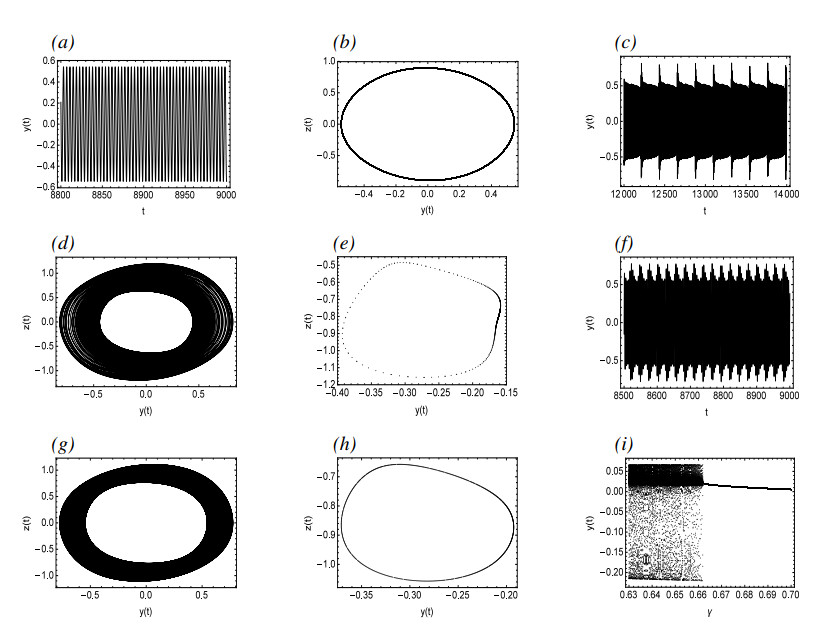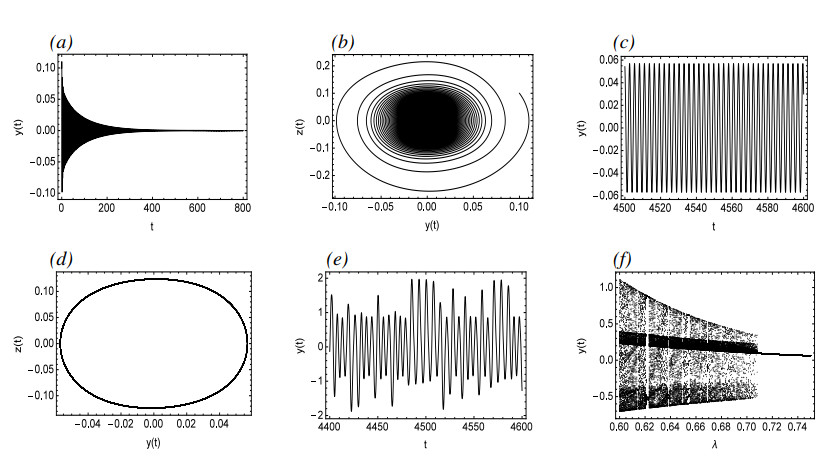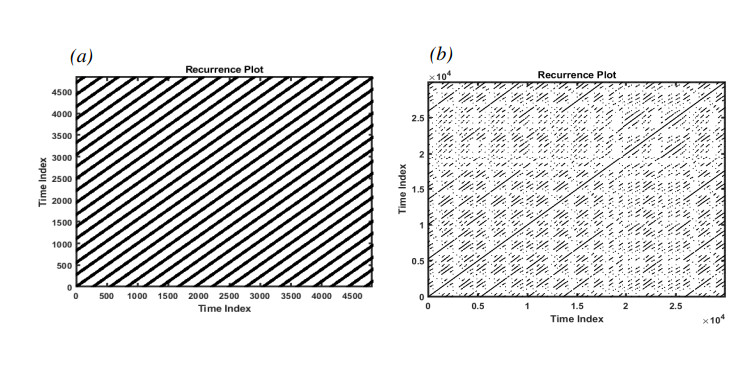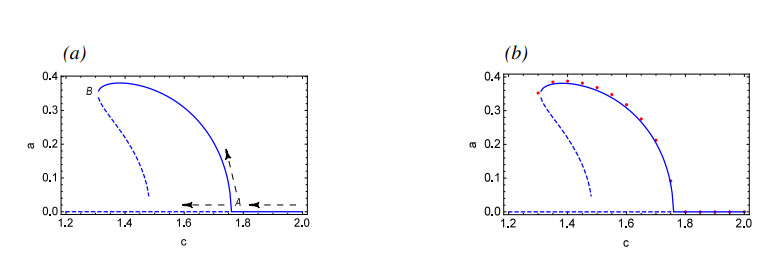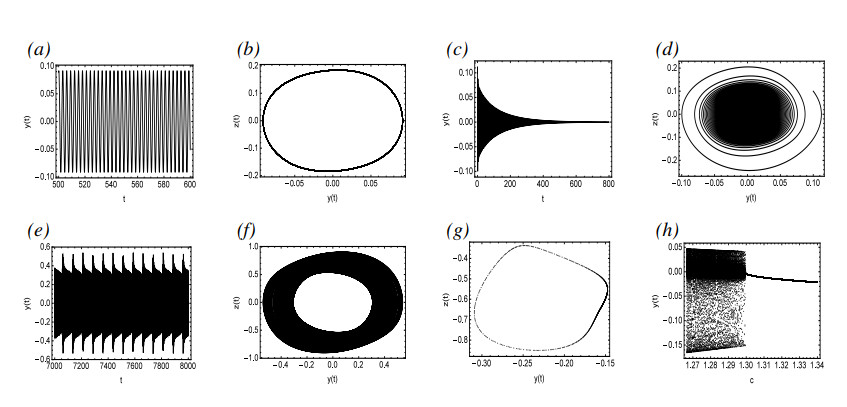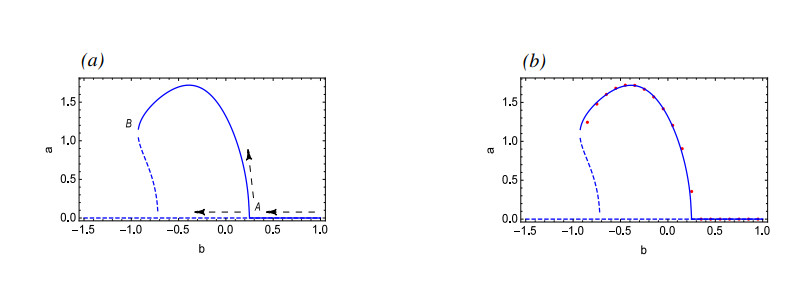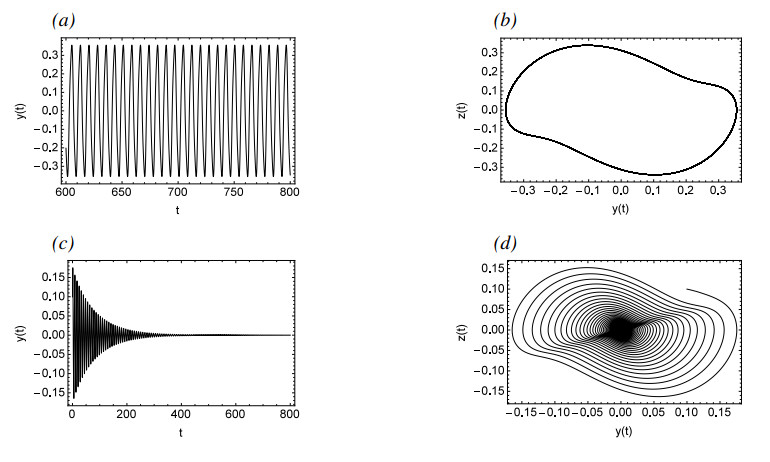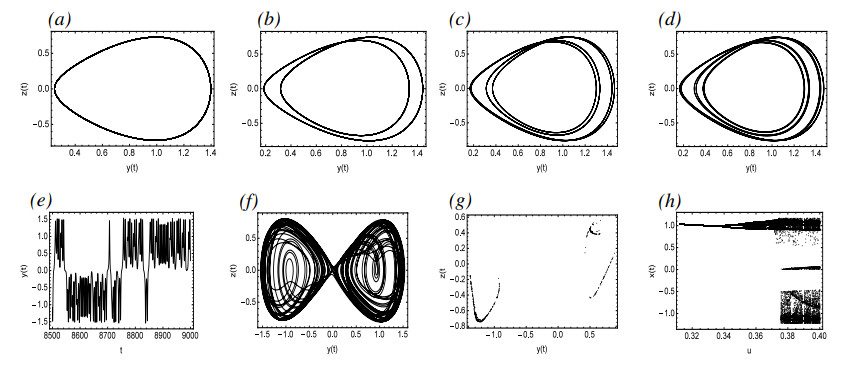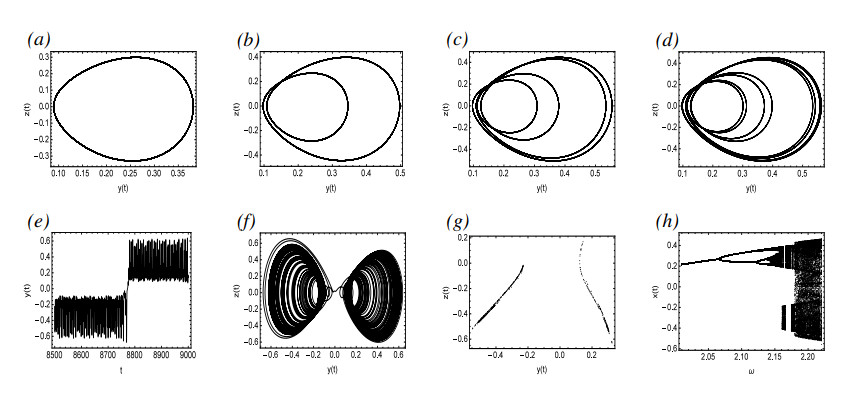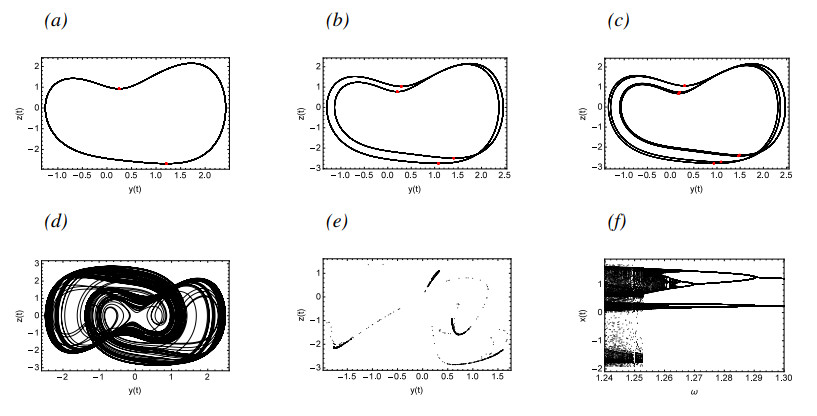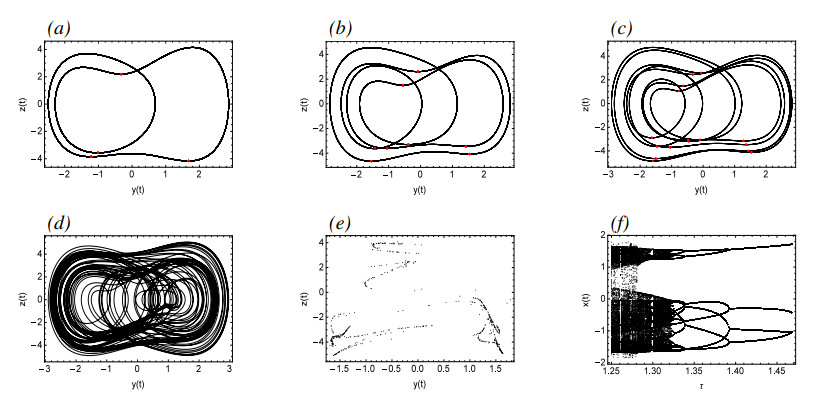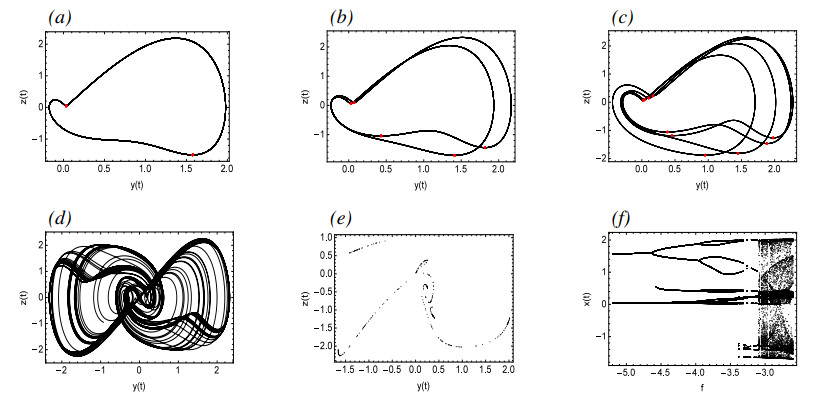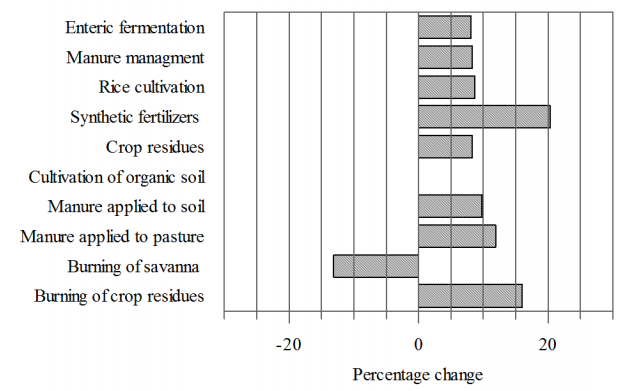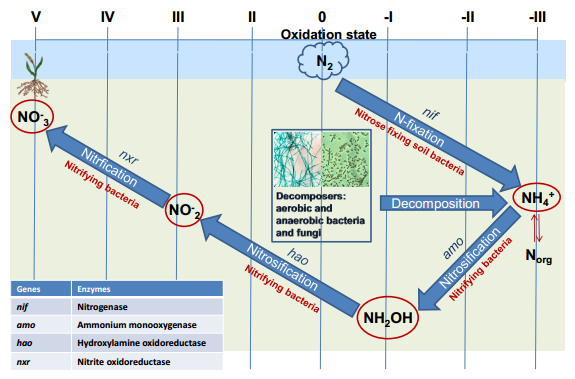| 1.
|
Qiangqiang Xiong, Jinlong Hu, Haiyan Wei, Hongcheng Zhang, Jinyan Zhu,
Relationship between Plant Roots, Rhizosphere Microorganisms, and Nitrogen and Its Special Focus on Rice,
2021,
11,
2077-0472,
234,
10.3390/agriculture11030234
|
|
| 2.
|
Mariagrazia P. Cataldi, Sigrid Heuer, Tim H. Mauchline, Mark D. Wilkinson, Emily Masters-Clark, Nilde A. Di Benedetto, Maria Rosaria Corbo, Zina Flagella,
Effect of Plant Growth Promoting Bacteria on the Growth of Wheat Seedlings Subjected to Phosphate Starvation,
2020,
10,
2073-4395,
978,
10.3390/agronomy10070978
|
|
| 3.
|
Umar Daraz, Yang Li, Qingye Sun, Mingzhu Zhang, Iftikhar Ahmad,
Inoculation of Bacillus spp. Modulate the soil bacterial communities and available nutrients in the rhizosphere of vetiver plant irrigated with acid mine drainage,
2021,
263,
00456535,
128345,
10.1016/j.chemosphere.2020.128345
|
|
| 4.
|
Oksana Lastochkina,
2019,
Chapter 6,
978-3-030-15174-4,
97,
10.1007/978-3-030-15175-1_6
|
|
| 5.
|
Valliappan Karuppiah, Yaqian Li, Jianan Sun, Murugappan Vallikkannu, Jie Chen,
Vel1 regulates the growth of Trichoderma atroviride during co-cultivation with Bacillus amyloliquefaciens and is essential for wheat root rot control,
2020,
151,
10499644,
104374,
10.1016/j.biocontrol.2020.104374
|
|
| 6.
|
O. Lastochkina, S. Aliniaeifard, M. Seifikalhor, R. Yuldashev, L. Pusenkova, S. Garipova,
2019,
Chapter 23,
978-981-13-6882-0,
579,
10.1007/978-981-13-6883-7_23
|
|
| 7.
|
Rachael E. Antwis, Ellen L. Fry, Chloë E. James, Natalie Ferry,
2020,
Chapter Nine,
9781108654418,
182,
10.1017/9781108654418.009
|
|
| 8.
|
Umme Aminun Naher, Jatish Chandra Biswas, Md. Maniruzzaman, Faruk Hossain Khan, Md. Imran Ullah Sarkar, Afsana Jahan, Md. Hasibur Rahaman Hera, Md. Belal Hossain, Aminul Islam, Md. Rafiqul Islam, Md. Shahjahan Kabir,
Bio-Organic Fertilizer: A Green Technology to Reduce Synthetic N and P Fertilizer for Rice Production,
2021,
12,
1664-462X,
10.3389/fpls.2021.602052
|
|
| 9.
|
Ayesha MUSTAFA, Muhammad IMRAN, Muhammad ASHRAF, Khalid MAHMOOD,
Perspectives of Using L-Tryptophan for Improving Productivity of Agricultural Crops: A Review,
2018,
28,
10020160,
16,
10.1016/S1002-0160(18)60002-5
|
|
| 10.
|
Nilde Antonella Di Benedetto, Daniela Campaniello, Antonio Bevilacqua, Mariagrazia Pia Cataldi, Milena Sinigaglia, Zina Flagella, Maria Rosaria Corbo,
Isolation, Screening, and Characterization of Plant-Growth-Promoting Bacteria from Durum Wheat Rhizosphere to Improve N and P Nutrient Use Efficiency,
2019,
7,
2076-2607,
541,
10.3390/microorganisms7110541
|
|
| 11.
|
Zipora Tietel, Ella Simhon, Kelem Gashu, Devanesan Arul Ananth, Betty Schwartz, Yehoshua Saranga, Uri Yermiyahu,
Nitrogen availability and genotype affect major nutritional quality parameters of tef grain grown under irrigation,
2020,
10,
2045-2322,
10.1038/s41598-020-71299-x
|
|
| 12.
|
Giancarlo Pagnani, Angelica Galieni, Fabio Stagnari, Marika Pellegrini, Maddalena Del Gallo, Michele Pisante,
Open field inoculation with PGPR as a strategy to manage fertilization of ancient Triticum genotypes,
2020,
56,
0178-2762,
111,
10.1007/s00374-019-01407-1
|
|
| 13.
|
Yueyue Li, Min Zhao, Wenwen Chen, Hongyi Du, Xiaodong Xie, Daibin Wang, Ya Dai, Qingyou Xia, Genhong Wang,
Comparative transcriptomic analysis reveals that multiple hormone signal transduction and carbohydrate metabolic pathways are affected by Bacillus cereus in Nicotiana tabacum,
2020,
112,
08887543,
4254,
10.1016/j.ygeno.2020.07.022
|
|
| 14.
|
Alemayehu Getahun, Diriba Muleta, Fassil Assefa, Solomon Kiros,
2019,
Chapter 7,
978-981-13-8800-2,
147,
10.1007/978-981-13-8801-9_7
|
|
| 15.
|
Simin Irankhah, Ali Ganjeali, Mansour Mashreghi, Zahra Lari,
Mixed inoculum of rhizobacteria and arbuscular mycorrhizal fungus enhance diosgenin contain and phosphorus uptake in Fenugreek under drought stress,
2021,
24522198,
100338,
10.1016/j.rhisph.2021.100338
|
|
| 16.
|
Oluwaseyi Samuel Olanrewaju, Ayansina Segun Ayangbenro, Bernard R. Glick, Olubukola Oluranti Babalola,
Plant health: feedback effect of root exudates-rhizobiome interactions,
2019,
103,
0175-7598,
1155,
10.1007/s00253-018-9556-6
|
|
| 17.
|
Becky Nancy Aloo, Vishal Tripathi, Ernest R. Mbega, Billy A. Makumba,
2021,
Chapter 12,
978-3-030-65446-7,
267,
10.1007/978-3-030-65447-4_12
|
|
| 18.
|
Alexander Calero Hurtado, Yanery Pérez Díaz, Dilier Olivera Viciedo, Elieni Quintero Rodríguez, Kolima Peña Calzada, Luke Leroy Theodore Nedd, Janet Jiménez Hernández,
Effect of different application forms of efficient microorganisms on the agricultural productive of two bean cultivars,
2019,
72,
2248-7026,
8927,
10.15446/rfnam.v72n3.76272
|
|
| 19.
|
Baby Kumari, Anjali Chandrol Solanki, M.A. Mallick,
2021,
9780128197158,
429,
10.1016/B978-0-12-819715-8.00015-X
|
|
| 20.
|
Kanika Khanna, Dhriti Kapoor, Priyanka Sharma, Palak Bakshi, Pooja Sharma, Poonam Saini, Puja Ohri, Bilal Ahmad Mir, Rupinder Kaur, Renu Bhardwaj,
2020,
Chapter 26,
978-981-15-2155-3,
717,
10.1007/978-981-15-2156-0_26
|
|
| 21.
|
Bakari Chaka, Wyclife Olal, Aloys Osano, Evans Suter, Martin Magu, Abdallah Marjan, Moses Kehongo, Geoffrey Mwendwa,
The influence of Bomet red rock powder on composite organic fertilizers prepared from Tithonia diversifolia leaves and Musa acuminata (banana) stalks,
2020,
43,
0190-4167,
2685,
10.1080/01904167.2020.1793178
|
|
| 22.
|
Aisha Sumbul, Rizwan Ali Ansari, Rose Rizvi, Irshad Mahmood,
Azotobacter: A potential bio-fertilizer for soil and plant health management,
2020,
27,
1319562X,
3634,
10.1016/j.sjbs.2020.08.004
|
|
| 23.
|
Satyavir S. Sindhu, Ruchi Sharma, Swati Sindhu, Anju Sehrawat,
2019,
Chapter 7,
978-981-13-5903-3,
101,
10.1007/978-981-13-5904-0_7
|
|
| 24.
|
Sanjana Kaul, Suruchi Gupta, Tanwi Sharma, Manoj K. Dhar,
2018,
Chapter 14,
978-3-319-75909-8,
341,
10.1007/978-3-319-75910-4_14
|
|
| 25.
|
Rimsha Zainab, Ghulam Mujtaba Shah, Waqar Khan, Ayaz Mehmood, Rashid Azad, Khurram Shahzad, Zahid Hussain Shah, Fahad Alghabari, Tariq Sultan, Gyuhwa Chung,
Efficiency of plant growth promoting bacteria for growth and yield enhancement of maize (Zea mays) isolated from rock phosphate reserve area Hazara Khyber Pakhtunkhwa, Pakistan,
2021,
1319562X,
10.1016/j.sjbs.2021.01.025
|
|
| 26.
|
Jana Fahrion, Carina Fink, Paul Zabel, Daniel Schubert, Mohamed Mysara, Rob Van Houdt, Bernhard Eikmanns, Kristina Beblo-Vranesevic, Petra Rettberg,
Microbial Monitoring in the EDEN ISS Greenhouse, a Mobile Test Facility in Antarctica,
2020,
11,
1664-302X,
10.3389/fmicb.2020.00525
|
|
| 27.
|
Douglas Mariani Zeffa, Luiz Júnior Perini, Mayara Barbosa Silva, Nicholas Vieira de Sousa, Carlos Alberto Scapim, André Luiz Martinez de Oliveira, Antônio Teixeira do Amaral Júnior, Leandro Simões Azeredo Gonçalves, P. Pardha-Saradhi,
Azospirillum brasilense promotes increases in growth and nitrogen use efficiency of maize genotypes,
2019,
14,
1932-6203,
e0215332,
10.1371/journal.pone.0215332
|
|
| 28.
|
Vladimir Gorshkov, Elena Osipova, Mira Ponomareva, Sergey Ponomarev, Natalia Gogoleva, Olga Petrova, Olga Gogoleva, Azat Meshcherov, Alexander Balkin, Elena Vetchinkina, Kim Potapov, Yuri Gogolev, Viktor Korzun,
Rye Snow Mold-Associated Microdochium nivale Strains Inhabiting a Common Area: Variability in Genetics, Morphotype, Extracellular Enzymatic Activities, and Virulence,
2020,
6,
2309-608X,
335,
10.3390/jof6040335
|
|
| 29.
|
Akanksha Singh, Rupesh Chaubey, Stuti Srivastava, Sumit Kushwaha, Rakesh Pandey,
2021,
Chapter 16,
978-981-15-6274-7,
343,
10.1007/978-981-15-6275-4_16
|
|
| 30.
|
Zerihun T. Dame, Mahfuz Rahman, Tofazzal Islam,
Bacilli as sources of agrobiotechnology: recent advances and future directions,
2021,
14,
1751-8253,
245,
10.1080/17518253.2021.1905080
|
|
| 31.
|
Muthuraja Raji, Muthukumar Thangavelu,
Isolation and screening of potassium solubilizing bacteria from saxicolous habitat and their impact on tomato growth in different soil types,
2021,
0302-8933,
10.1007/s00203-021-02284-9
|
|
| 32.
|
Umair Riaz, Laila Shahzad, Wajiha Anum, Anam Waheed,
2021,
chapter 5,
9781799870623,
135,
10.4018/978-1-7998-7062-3.ch005
|
|
| 33.
|
Shraddha Gang, Sheetal Sharma, Meenu Saraf, Martin Buck, Jorg Schumacher,
Bacterial Indole-3-Acetic Acid Influences Soil Nitrogen Acquisition in Barley and Chickpea,
2021,
10,
2223-7747,
780,
10.3390/plants10040780
|
|
| 34.
|
Arkadiusz Stępień, Katarzyna Wojtkowiak, Ewelina Kolankowska,
Effect of Commercial Microbial Preparations Containing Paenibacillus azotofixans, Bacillus megaterium and Bacillus subtilis on the Yield and Photosynthesis of Winter Wheat and the Nitrogen and Phosphorus Content in the Soil,
2022,
12,
2076-3417,
12541,
10.3390/app122412541
|
|
| 35.
|
Charles Oluwaseun Adetunji, Osikemekha Anthony Anani, Olugbemi T. Olaniyan, Abel Inobeme, Frances N. Olisaka, Eseosa Oluwadamilare Uwadiae, Omoregbe Nosa Obayagbona,
2021,
Chapter 20,
978-981-16-2921-1,
507,
10.1007/978-981-16-2922-8_20
|
|
| 36.
|
Anmol Gupta, Richa Mishra, Smita Rai, Ambreen Bano, Neelam Pathak, Masayuki Fujita, Manoj Kumar, Mirza Hasanuzzaman,
Mechanistic Insights of Plant Growth Promoting Bacteria Mediated Drought and Salt Stress Tolerance in Plants for Sustainable Agriculture,
2022,
23,
1422-0067,
3741,
10.3390/ijms23073741
|
|
| 37.
|
Pragya Tiwari, Subir Kumar Bose, Hanhong Bae,
2021,
Chapter 1,
978-3-030-73506-7,
1,
10.1007/978-3-030-73507-4_1
|
|
| 38.
|
Michal Styczynski, Gabriel Biegniewski, Przemyslaw Decewicz, Bartosz Rewerski, Klaudia Debiec-Andrzejewska, Lukasz Dziewit,
Application of Psychrotolerant Antarctic Bacteria and Their Metabolites as Efficient Plant Growth Promoting Agents,
2022,
10,
2296-4185,
10.3389/fbioe.2022.772891
|
|
| 39.
|
Federica Massa, Roberto Defez, Carmen Bianco,
Exploitation of Plant Growth Promoting Bacteria for Sustainable Agriculture: Hierarchical Approach to Link Laboratory and Field Experiments,
2022,
10,
2076-2607,
865,
10.3390/microorganisms10050865
|
|
| 40.
|
Magdalena Anna Karaś, Sylwia Wdowiak-Wróbel, Wojciech Sokołowski,
Selection of Endophytic Strains for Enhanced Bacteria-Assisted Phytoremediation of Organic Pollutants Posing a Public Health Hazard,
2021,
22,
1422-0067,
9557,
10.3390/ijms22179557
|
|
| 41.
|
Salmina N. Mokgehle, Hintsa T. Araya, Nadia A. Araya, Michael W. Bairu, Manaka J. Makgato, Motiki M. Mofokeng, Phomolo Maphothoma, Christian P. du Plooy, Stephen O. Amoo,
2021,
9780128230480,
237,
10.1016/B978-0-12-823048-0.00001-0
|
|
| 42.
|
Paola Ganugi, Andrea Fiorini, Gabriele Rocchetti, Paolo Bonini, Vincenzo Tabaglio, Luigi Lucini,
A response surface methodology approach to improve nitrogen use efficiency in maize by an optimal mycorrhiza-to-Bacillus co-inoculation rate,
2022,
13,
1664-462X,
10.3389/fpls.2022.956391
|
|
| 43.
|
Silvina Brambilla, Margarita Stritzler, Gabriela Soto, Nicolas Ayub,
A synthesis of functional contributions of rhizobacteria to growth promotion in diverse crops,
2022,
24,
24522198,
100611,
10.1016/j.rhisph.2022.100611
|
|
| 44.
|
Parul Chaudhary, Heena Parveen, Saurabh Gangola, Govind Kumar, Pankaj Bhatt, Anuj Chaudhary,
2021,
Chapter 13,
978-981-16-3839-8,
217,
10.1007/978-981-16-3840-4_13
|
|
| 45.
|
Azadeh Jamalzadeh, Mostafa Darvishnia, Gholam Khodakaramian, Doostmorad Zafari, Eydi Bazgir,
Effect of antagonistic bacteria associated with canola on disease suppression,
2023,
0929-1873,
10.1007/s10658-022-02633-4
|
|
| 46.
|
Aline Figueiredo Cardoso, Ediane Conceição Alves, Sidney D. Araújo da Costa, Alessandra Jackeline Guedes de Moraes, Dalton Dias da Silva Júnior, Paulo Manoel Pontes Lins, Gisele Barata da Silva,
Bacillus cereus Improves Performance of Brazilian Green Dwarf Coconut Palms Seedlings With Reduced Chemical Fertilization,
2021,
12,
1664-462X,
10.3389/fpls.2021.649487
|
|
| 47.
|
Wenjing Li, Yan Li, Jie Lv, Xuemin He, Jinlong Wang, Dexiong Teng, Lamei Jiang, Hengfang Wang, Guanghui Lv,
Rhizosphere effect alters the soil microbiome composition and C, N transformation in an arid ecosystem,
2022,
170,
09291393,
104296,
10.1016/j.apsoil.2021.104296
|
|
| 48.
|
Dwaipayan Sinha, Satarupa Dey, Anjana Singh,
2022,
Chapter 14,
978-3-031-08829-2,
297,
10.1007/978-3-031-08830-8_14
|
|
| 49.
|
Vitaliy V. Volkogon, Lyudmyla V. Potapenko, Mykola V. Volkogon,
Vertical migration of nutrients and water-soluble organic matter in the soil profile under pre-sowing seed treatment with plant growth promoting rhizobacteria,
2023,
6,
2571-581X,
10.3389/fsufs.2022.1054113
|
|
| 50.
|
Arshad Jalal, Carlos Eduardo da Silva Oliveira, Andréa de Castro Bastos, Guilherme Carlos Fernandes, Bruno Horschut de Lima, Enes Furlani Junior, Pedro Henrique Gomes de Carvalho, Fernando Shintate Galindo, Isabela Martins Bueno Gato, Marcelo Carvalho Minhoto Teixeira Filho,
Nanozinc and plant growth-promoting bacteria improve biochemical and metabolic attributes of maize in tropical Cerrado,
2023,
13,
1664-462X,
10.3389/fpls.2022.1046642
|
|
| 51.
|
Mingma Thundu Sherpa, Niladri Bag, Sayak Das, Paolenmang Haokip, Laxuman Sharma,
Isolation and characterization of plant growth promoting rhizobacteria isolated from organically grown high yielding pole type native pea (Pisum sativum L.) variety Dentami of Sikkim, India,
2021,
2,
26665174,
100068,
10.1016/j.crmicr.2021.100068
|
|
| 52.
|
Suman Chaudhary, Satyavir Singh Sindhu, Rinku Dhanker, Anju Kumari,
Microbes-mediated sulphur cycling in soil: Impact on soil fertility, crop production and environmental sustainability,
2023,
09445013,
127340,
10.1016/j.micres.2023.127340
|
|
| 53.
|
Galina V. Mirskaya, Yuriy V. Khomyakov, Nataliya A. Rushina, Vitaliy E. Vertebny, Elena P. Chizhevskaya, Vladimir K. Chebotar, Yuriy V. Chesnokov, Veronika N. Pishchik,
Plant Development of Early-Maturing Spring Wheat (Triticum aestivum L.) under Inoculation with Bacillus sp. V2026,
2022,
11,
2223-7747,
1817,
10.3390/plants11141817
|
|
| 54.
|
Saba Azeem, Syed Inayatullah Agha, Neelam Jamil, Bushra Tabassum, Shan Ahmed, Asif Raheem, Nusrat Jahan, Niaz Ali, Anwar Khan,
Characterization and survival of broad-spectrum biocontrol agents against phytopathogenic fungi,
2022,
54,
03257541,
233,
10.1016/j.ram.2021.10.005
|
|
| 55.
|
B. N. Aloo, E. R. Mbega, J. B. Tumuhairwe, B. A. Makumba,
Advancement and practical applications of rhizobacterial biofertilizers for sustainable crop production in sub-Saharan Africa,
2021,
10,
2048-7010,
10.1186/s40066-021-00333-6
|
|
| 56.
|
Becky Nancy Aloo, Ernest Rashid Mbega, Billy Amendi Makumba, John Baptist Tumuhairwe,
Effects of Carrier Materials and Storage Temperatures on the Viability and Stability of Three Biofertilizer Inoculants Obtained from Potato (Solanum tuberosum L.) Rhizosphere,
2022,
12,
2077-0472,
140,
10.3390/agriculture12020140
|
|
| 57.
|
Soumyadev Sarkar, Abigail Kamke, Kaitlyn Ward, Eli Hartung, Qinghong Ran, Brandi Feehan, Matthew Galliart, Ari Jumpponen, Loretta Johnson, Sonny T.M. Lee,
Pseudomonas cultivated from Andropogon gerardii rhizosphere show functional potential for promoting plant host growth and drought resilience,
2022,
23,
1471-2164,
10.1186/s12864-022-09019-0
|
|
| 58.
|
Danka Radić, Vera Karličić, Jelena Đorđević, Jelena Jovičić-Petrović, Igor Kljujev, Blažo Lalević, Vera Raičević,
Soil yeasts promoting plant growth: benefits for the development of common wheat and white mustard,
2022,
109,
1392-3196,
27,
10.13080/z-a.2022.109.004
|
|
| 59.
|
Ziliang Zhang, Bhupinder Singh Jatana, Barbara J. Campbell, Jasmine Gill, Vidya Suseela, Nishanth Tharayil,
Cross‐inoculation of rhizobiome from a congeneric ruderal plant imparts drought tolerance in maize (
Zea mays
) through changes in root morphology and proteome
,
2022,
111,
0960-7412,
54,
10.1111/tpj.15775
|
|
| 60.
|
Mario Hernández-Guzmán, Valentín Pérez-Hernández, Yendi E. Navarro-Noya, Marco L. Luna-Guido, Nele Verhulst, Bram Govaerts, Luc Dendooven,
Application of ammonium to a N limited arable soil enriches a succession of bacteria typically found in the rhizosphere,
2022,
12,
2045-2322,
10.1038/s41598-022-07623-4
|
|
| 61.
|
D. T. Nagrale, A. Chaurasia, S. Kumar, S. P. Gawande, N. S. Hiremani, Raja Shankar, N. Gokte-Narkhedkar, Y. G. Prasad,
PGPR: the treasure of multifarious beneficial microorganisms for nutrient mobilization, pest biocontrol and plant growth promotion in field crops,
2023,
39,
0959-3993,
10.1007/s11274-023-03536-0
|
|
| 62.
|
Priya Mishra, Ankita Bhattacharya, Priyanka Verma, Chanda Bharti, Naveen Kumar Arora,
2022,
Chapter 6,
978-981-16-4842-7,
205,
10.1007/978-981-16-4843-4_6
|
|
| 63.
|
Oksana Lastochkina, Sasan Aliniaeifard, Darya Garshina, Svetlana Garipova, Liudmila Pusenkova, Chulpan Allagulova, Kristina Fedorova, Andrey Baymiev, Igor Koryakov, Mohammadhadi Sobhani,
Seed priming with endophytic Bacillus subtilis strain-specifically improves growth of Phaseolus vulgaris plants under normal and salinity conditions and exerts anti-stress effect through induced lignin deposition in roots and decreased oxidative and osmotic damages,
2021,
263,
01761617,
153462,
10.1016/j.jplph.2021.153462
|
|
| 64.
|
Theerthankar Das, Brandon C. Young,
2022,
Chapter 1,
978-1-80355-795-3,
10.5772/intechopen.106775
|
|
| 65.
|
Christopher R. Dumigan, Jade Muileboom, Jake Gregory, Anuja Shrestha, Omar A. Hewedy, Manish N. Raizada,
Ancient Relatives of Modern Maize From the Center of Maize Domestication and Diversification Host Endophytic Bacteria That Confer Tolerance to Nitrogen Starvation,
2021,
12,
1664-462X,
10.3389/fpls.2021.660673
|
|
| 66.
|
T. G. Weldmichael, D. Márton, B. Simon, E. Michéli, G. T. Reda, F. Adiyah, M. Cserháti,
Bacterial Community Characterization and Microbial Respiration of Selected Arable Soils of Ethiopia,
2021,
54,
1064-2293,
1921,
10.1134/S1064229321120140
|
|
| 67.
|
Ângela Fernandes, Christina Chaski, Carla Pereira, Marina Kostić, Youssef Rouphael, Marina Soković, Lillian Barros, Spyridon A. Petropoulos,
Water Stress Alleviation Effects of Biostimulants on Greenhouse-Grown Tomato Fruit,
2022,
8,
2311-7524,
645,
10.3390/horticulturae8070645
|
|
| 68.
|
Oksana Lastochkina, Sergey Ivanov, Svetlana Petrova, Darya Garshina, Alsu Lubyanova, Ruslan Yuldashev, Bulat Kuluev, Evgenia Zaikina, Dilara Maslennikova, Chulpan Allagulova, Irina Avtushenko, Albina Yakupova, Rashit Farkhutdinov,
Role of Endogenous Salicylic Acid as a Hormonal Intermediate in the Bacterial Endophyte Bacillus subtilis-Induced Protection of Wheat Genotypes Contrasting in Drought Susceptibility under Dehydration,
2022,
11,
2223-7747,
3365,
10.3390/plants11233365
|
|
| 69.
|
Angelica Mendoza Beltran, Claus Nordstrøm Scheel, Nuala Fitton, Jannick Schmidt, Jesper Hedal Kløverpris,
Assessing life cycle environmental impacts of inoculating soybeans in Argentina with Bradyrhizobium japonicum,
2021,
26,
0948-3349,
1570,
10.1007/s11367-021-01929-7
|
|
| 70.
|
Kalaivani K. Nadarajah,
2022,
Chapter 1,
978-981-16-8917-8,
1,
10.1007/978-981-16-8918-5_1
|
|
| 71.
|
Jun Haeng Nam, Alyssa Thibodeau, Yanping L. Qian, Michael C. Qian, Si Hong Park,
Multidisciplinary evaluation of plant growth promoting rhizobacteria on soil microbiome and strawberry quality,
2023,
13,
2191-0855,
10.1186/s13568-023-01524-z
|
|
| 72.
|
Mahfuz Rahman, Md Nur Alam Miah, Whitney Dudding,
2022,
Chapter 8,
978-3-030-85464-5,
169,
10.1007/978-3-030-85465-2_8
|
|
| 73.
|
Abbas Soleymanifard, Mani Mojaddam, Shahram Lack, Mojtaba Alavifazel,
Effect of Azotobacter Chroococcum and Nitrogen Fertilization on Some Morphophysiological Traits, Grain Yield, and Nitrogen Use Efficiency of Safflower Genotypes in Rainfed Conditions,
2022,
53,
0010-3624,
773,
10.1080/00103624.2022.2028815
|
|
| 74.
|
Fernanda Plucani do Amaral, Juexin Wang, Jacob Williams, Thalita R. Tuleski, Trupti Joshi, Marco A. R. Ferreira, Gary Stacey,
Mapping Genetic Variation in Arabidopsis in Response to Plant Growth-Promoting Bacterium Azoarcus olearius DQS-4T,
2023,
11,
2076-2607,
331,
10.3390/microorganisms11020331
|
|
| 75.
|
Yu Zhao, Sicen Liu, Bing He, Min Sun, Jishou Li, Rong Peng, Liangliang Sun, Xiaopeng Wang, Youpeng Cai, Hehe Wang, Xueqing Geng,
Phosphate-solubilising bacteria promote horticultural plant growth through phosphate solubilisation and phytohormone regulation,
2022,
0114-0671,
1,
10.1080/01140671.2022.2103156
|
|
| 76.
|
Jaya Gangwar, Joseph Kadanthottu Sebastian, Juhi Puthukulangara Jaison, Jissa Theresa Kurian,
Nano-technological interventions in crop production—a review,
2023,
29,
0971-5894,
93,
10.1007/s12298-022-01274-5
|
|
| 77.
|
Shalja Verma, Anand Kumar Pandey,
2022,
9780323855778,
435,
10.1016/B978-0-323-85577-8.00022-6
|
|
| 78.
|
Vanja Vlajkov, Ivana Pajčin, Snežana Vučetić, Stefan Anđelić, Marta Loc, Mila Grahovac, Jovana Grahovac,
Bacillus-Loaded Biochar as Soil Amendment for Improved Germination of Maize Seeds,
2023,
12,
2223-7747,
1024,
10.3390/plants12051024
|
|
| 79.
|
Gulcin Sevim, Fadime Ozdemir-Kocak, Dilek Unal,
2023,
9780323918831,
187,
10.1016/B978-0-323-91883-1.00013-9
|
|
| 80.
|
Rubén Bottini, Federico J. Berli, M. Victoria Salomon, Patricia N. Piccoli,
2023,
Chapter 5,
978-981-19-9569-9,
75,
10.1007/978-981-19-9570-5_5
|
|
| 81.
|
O. V. Lastochkina, Ch. R. Allagulova,
The Mechanisms of the Growth Promotion and Protective Effects of Endophytic PGP Bacteria in Wheat Plants Under the Impact of Drought (Review),
2023,
59,
0003-6838,
14,
10.1134/S0003683823010039
|
|
| 82.
|
Hassan Etesami, Byoung Ryong Jeong, Bernard R. Glick,
Potential use of Bacillus spp. as an effective biostimulant against abiotic stresses in crops—A review,
2023,
25902628,
100128,
10.1016/j.crbiot.2023.100128
|
|
| 83.
|
Waqas Mohy-Ud-Din, Muhammad Javed Akhtar, Safdar Bashir, Hafiz Naeem Asghar, Muhammad Farrakh Nawaz, Feng Chen,
Isolation of Glyphosate-Resistant Bacterial Strains to Improve the Growth of Maize and Degrade Glyphosate under Axenic Condition,
2023,
13,
2077-0472,
886,
10.3390/agriculture13040886
|
|
| 84.
|
Oksana Lastochkina, Albina Yakupova, Irina Avtushenko, Artem Lastochkin, Ruslan Yuldashev,
Effect of Seed Priming with Endophytic Bacillus subtilis on Some Physio-Biochemical Parameters of Two Wheat Varieties Exposed to Drought after Selective Herbicide Application,
2023,
12,
2223-7747,
1724,
10.3390/plants12081724
|
|
| 85.
|
Rafael Massahiro Yassue, Giovanni Galli, Chun‐Peng James Chen, Roberto Fritsche‐Neto, Gota Morota,
Genome‐wide association analysis of hyperspectral reflectance data to dissect the genetic architecture of growth‐related traits in maize under plant growth‐promoting bacteria inoculation,
2023,
7,
2475-4455,
10.1002/pld3.492
|
|
| 86.
|
Murugan Kumar, Waquar Akhter Ansari, Mohammad Tarique Zeyad, Arjun Singh, Hillol Chakdar, Adarsh Kumar, Mohammad Samir Farooqi, Anu Sharma, Sudhir Srivastava, Alok Kumar Srivastava,
Core microbiota of wheat rhizosphere under Upper Indo-Gangetic plains and their response to soil physicochemical properties,
2023,
14,
1664-462X,
10.3389/fpls.2023.1186162
|
|
| 87.
|
Joaquin Gomis‐Cebolla, Colin Berry,
Bacillus thuringiensis as a biofertilizer in crops and their implications in the control of phytopathogens and insect pests,
2023,
1526-498X,
10.1002/ps.7560
|
|
| 88.
|
O. V. Lastochkina, S. R. Garipova, L. I. Pusenkova, D. Yu. Garshina, An. Kh. Baymiev, I. S. Koryakov,
Effect of Endophytic Bacteria Bacillus subtilis on Seedling Growth and Root Lignification of Pisum sativum L. under Normal and Sodium Chloride Salt Conditions,
2023,
70,
1021-4437,
10.1134/S102144372360085X
|
|
| 89.
|
Ramesh Chandra Yadav, Sushil K. Sharma, Ajit Varma, Udai B. Singh, Adarsh Kumar, Ingudam Bhupenchandra, Jai P. Rai, Pawan K. Sharma, Harsh V. Singh,
Zinc-solubilizing Bacillus spp. in conjunction with chemical fertilizers enhance growth, yield, nutrient content, and zinc biofortification in wheat crop,
2023,
14,
1664-302X,
10.3389/fmicb.2023.1210938
|
|
| 90.
|
Upasna Chettry, Sunita Upadhaya, Amilia Nongbet, Nikhil Kumar Chrungoo, S. R. Joshi,
2023,
Chapter 8,
978-981-99-2815-6,
243,
10.1007/978-981-99-2816-3_8
|
|
| 91.
|
Sameh H Youseif, Fayrouz H Abd El-Megeed, Mousa S Salous, Akram H Mohamed,
Streptomyces biostimulants: an effective sustainable approach to reduce inorganic N input and maintain high yield of wheat crop in different soil types,
2023,
134,
1365-2672,
10.1093/jambio/lxad156
|
|
| 92.
|
Israr Asghar, Maqsood Ahmed, Muhammad Ansar Farooq, Muhammad Ishtiaq, Muhammad Arshad, Muhammad Akram, Adnan Umair, Abdulwahed Fahad Alrefaei, Muhammad Yousuf Jat Baloch, Aamna Naeem,
Characterizing indigenous plant growth promoting bacteria and their synergistic effects with organic and chemical fertilizers on wheat (Triticum aestivum),
2023,
14,
1664-462X,
10.3389/fpls.2023.1232271
|
|
| 93.
|
Lingjian Wang, Xinggang Tang, Xin Liu, Jinchi Zhang,
Active permanent greening – a new slope greening technology based on mineral solubilizing microorganisms,
2023,
14,
1664-462X,
10.3389/fpls.2023.1219139
|
|
| 94.
|
Jiayu Li, Juntao Wang, Hongwei Liu, Catriona A. Macdonald, Brajesh K. Singh,
Microbial inoculants with higher capacity to colonize soils improved wheat drought tolerance,
2023,
16,
1751-7915,
2131,
10.1111/1751-7915.14350
|
|
| 95.
|
Dibya Jyoti Hazarika, Sudipta Sankar Bora, Romen Singh Naorem, Darshana Sharma, Robin Chandra Boro, Madhumita Barooah,
Genomic insights into Bacillus subtilis MBB3B9 mediated aluminium stress mitigation for enhanced rice growth,
2023,
13,
2045-2322,
10.1038/s41598-023-42804-9
|
|
| 96.
|
Sekar Hamsa, Ruby Tiwari, Chanderkant Chaudhary,
2023,
9789815124033,
293,
10.2174/9789815124033123010019
|
|
| 97.
|
Mingzheng Duan, Chengcui Yang, Liuyuan Bao, Duo Han, Huaizheng Wang, Yongzhi Zhang, Honggao Liu, Shunqiang Yang,
Morchella esculenta cultivation in fallow paddy fields and drylands affects the diversity of soil bacteria and soil chemical properties,
2023,
14,
1664-8021,
10.3389/fgene.2023.1251695
|
|
| 98.
|
Muazu Issifu, Labode Hospice Stevenson Naitchede, Elijah Miinda Ateka, Justus Onguso, Victoria Wambui Ngumi,
Synergistic effects of substrate inoculation with Pseudomonas strains on tomato phenology, yield, and selected human health‐related phytochemical compounds,
2023,
6,
2639-6696,
10.1002/agg2.20435
|
|
| 99.
|
Ankita Kumari, Archana Kumari, Himanshu Sharma, Priyanka Sharma, Sayan Bhattacharya, Tulika Mishra, Abdel Rahman Al-Tawaha, Milan Kumar Lal, Rahul Kumar Tiwari, Sayanti Mandal, Abhijit Dey,
2023,
Chapter 4,
978-3-031-43728-1,
69,
10.1007/978-3-031-43729-8_4
|
|
| 100.
|
Neha Sharma, Sandeep Sharma,
2023,
Chapter 11,
978-981-99-3105-7,
287,
10.1007/978-981-99-3106-4_11
|
|
| 101.
|
Vladislava S. Maslennikova, Vera P. Tsvetkova, Evgenia V. Shelikhova, Marina P. Selyuk, Tatyana Y. Alikina, Marsel R. Kabilov, Ivan M. Dubovskiy,
Bacillus subtilis and Bacillus amyloliquefaciens Mix Suppresses Rhizoctonia Disease and Improves Rhizosphere Microbiome, Growth and Yield of Potato (Solanum tuberosum L.),
2023,
9,
2309-608X,
1142,
10.3390/jof9121142
|
|
| 102.
|
Wogene Solomon, Lamnganbi Mutum, Mariann Rakszegi, Tibor Janda, Zoltán Molnár,
Harnessing the Synergy of the Cyanobacteria-Plant Growth Promoting Bacteria for Improved Maize (Zea mays) Growth and Soil Health,
2023,
15,
2071-1050,
16660,
10.3390/su152416660
|
|
| 103.
|
María Carmen Piñero, Jacinta Collado-González, Ginés Otálora, Josefa López-Marín, Francisco M. del Amor,
Plant Growth Promoting Bacteria for Aquaponics as a New Strategy That Grants Quality and Nutrient Efficiency in Kohlrabi Cultivation,
2023,
9,
2311-7524,
1299,
10.3390/horticulturae9121299
|
|
| 104.
|
Fei Li, Kuanling Xi, Yuke Li, Tang Ming, Yufeng Huang, Lijun Zhang,
Genome-wide analysis of transmembrane 9 superfamily genes in wheat (Triticum aestivum) and their expression in the roots under nitrogen limitation and Bacillus amyloliquefaciens PDR1 treatment conditions,
2024,
14,
1664-462X,
10.3389/fpls.2023.1324974
|
|
| 105.
|
Hassan Etesami, Bernard R. Glick,
Bacterial indole-3-acetic acid: A key regulator for plant growth, plant-microbe interactions, and agricultural adaptive resilience,
2024,
09445013,
127602,
10.1016/j.micres.2024.127602
|
|
| 106.
|
2024,
9780443188558,
157,
10.1016/B978-0-443-18855-8.16001-1
|
|
| 107.
|
Marcos Renan Lima Leite, Romário Martins Costa, Mayanna Karlla Lima Costa, Janderson Moura da Silva, Sandra Mara Barbosa Rocha, Rafael de Sousa Miranda, Francisco de Alcantara Neto, Elaine Martins Costa, Alexson Filgueiras Dutra, Erika Valente de Medeiros, Arthur Prudencio de Araujo Pereira, Lucas William Mendes, Ademir Sérgio Ferreira Araujo,
Application of silicate changes the network complexity of plant growth-promoting rhizobacteria in the rhizosphere of sugarcane genotypes,
2024,
29,
24522198,
100855,
10.1016/j.rhisph.2024.100855
|
|
| 108.
|
María M. Labarthe, Guillermo A. Maroniche, Lorenzo Lamattina, Cecilia M. Creus,
Nitric oxide synthase expression in Pseudomonas koreensis MME3 improves plant growth promotion traits,
2024,
108,
0175-7598,
10.1007/s00253-024-13029-1
|
|
| 109.
|
Seerat Saleem, Naveed Ul Mushtaq, Wasifa Hafiz Shah, Aadil Rasool, Reiaz Ul Rehman,
2024,
9780443151996,
275,
10.1016/B978-0-443-15199-6.00017-8
|
|
| 110.
|
Zakaria Asbai, Fatimazahra Boutaleb, Fatima Ezzahra Doublali, Oumaima Mrabet, Meryem Hadidi, Bouchaib Bahlaouan, Said El Antri, Nadia Boutaleb,
Sustainable approach for nutrient release control in organic fertilisers by using phosphogypsum,
2024,
0020-7233,
1,
10.1080/00207233.2024.2322882
|
|
| 111.
|
Aline Cardozo Rosman, Maria Clara de Oliveira Urquiaga, Flávia Thiebaut, Helkin Giovani Forero Ballesteros, Eduardo Alves Gamosa de Oliveira, Adriana Silva Hemerly,
Dual RNA-seq of maize and H. seropedicae ZAE94 association, in different doses of nitrate, reveals novel insights into Plant-PGPB-environment relationship,
2024,
15,
1664-462X,
10.3389/fpls.2024.1346523
|
|
| 112.
|
Charu Singh, Abhishek Chauhan, Jayati Arora, Anuj Ranjan, Hardeep Singh Tuli, Moyad Shahwan, Vishnu D. Rajput, Tatiana Minkina, Sambasivan Venkat Eswaran, Tanu Jindal,
Exploration and Profiling of Potential Thermo-alkaliphilic Bacillus licheniformis and Burkholderia sp. from varied Soil of Delhi region, India and their Plant Growth-Promoting Traits,
2024,
12,
2320-8694,
60,
10.18006/2024.12(1).60.75
|
|
| 113.
|
Ahmad Nemati, Mohammad Ali Aboutalebian, Mehrdad Chaichi,
Mitigating the effects of water-deficit stress on potato growth and photosynthesis using mycorrhizal fungi and phosphate-solubilizing bacteria,
2024,
0021-8596,
1,
10.1017/S0021859624000169
|
|
| 114.
|
Viabhav Kumar Upadhayay, Sergio de los Santos Villalobos, S. T. M. Aravindharajan, Bharti Kukreti, Manoj Kumar Chitara, Vandana Jaggi, Adita Sharma, Ajay Veer Singh,
2024,
Chapter 5,
978-981-97-0632-7,
95,
10.1007/978-981-97-0633-4_5
|
|
| 115.
|
О. V. Lastochkina, Ch. R. Allagulova,
Mechanisms of Growth Promotional and Protective Effects of Endophytic PGP-Bacteria in Wheat Plants Under the Impact of Drought (Review),
2023,
59,
0555-1099,
17,
10.31857/S0555109923010038
|
|
| 116.
|
Reshma Patil, Aizi Nor Mazila Ramli, Ang Shu Xuan, Ng Zhi Xin, Nur Izyan Wan Azelee, Prakash Bhuyar,
Unlocking the growth potential: harnessing the power of synbiotics to enhance cultivation of Pleurotus spp.,
2024,
25,
1673-1581,
293,
10.1631/jzus.B2300383
|
|
| 117.
|
O. V. Lastochkina, S. R. Garipova, L. I. Pusenkova, D. Yu. Garshina, An. Kh. Baymiev, I. S. Koryakov,
Effect of Endophytic Bacteria Bacillus subtilis on Seedling Growth and Root Lignification of Pisum sativum L. under Normal and Sodium Chloride Salt Conditions,
2023,
70,
0015-3303,
514,
10.31857/S0015330322600838
|
|
| 118.
|
Gaurav Pal, Samiksha Saxena, Kanchan Kumar, Anand Verma, Deepak Kumar, Pooja Shukla, Ashutosh Pandey, James White, Satish K. Verma,
Seed endophytic bacterium Lysinibacillus sp. (ZM1) from maize (Zea mays L.) shapes its root architecture through modulation of auxin biosynthesis and nitrogen metabolism,
2024,
212,
09819428,
108731,
10.1016/j.plaphy.2024.108731
|
|
| 119.
|
Idriss Djoko Kouam, Laverdure Tchamani, Germain Ntsoli, Marie Amperes Bedine, Roland Wilfried Titti, Aoudou Yaouba,
2024,
Effect of Different Carriers and Storage Temperatures on the Viability of Bacillus thuringiensis B9 and Bacillus pacificus B11 Isolated from Tomato (Solanum lycopersicum L.) Rhizosphere,
27,
10.3390/IOCAG2023-17337
|
|
| 120.
|
Abdulazeez Muzemil, Abdulrasheed Buhari,
Emerging techniques for manipulating endocrine function in animal production: A comprehensive review,
2024,
8,
2602-3490,
92,
10.30704/http-www-jivs-net.1426047
|
|
| 121.
|
Shubhi Singh, Smriti Gaur,
2024,
9780443133183,
137,
10.1016/B978-0-443-13318-3.00018-5
|
|
| 122.
|
Wogene Solomon, Tibor Janda, Zoltan Molnar, X. Feng, M. Khondker,
Impact of the microalgae-bacteria interaction on maize (Zea mays L.) health and yield,
2024,
125,
2117-4458,
03004,
10.1051/bioconf/202412503004
|
|
| 123.
|
Olga Maslovska, Solomiia Komplikevych, Iryna Danylo, Ivan Parnikoza, Svitlana Hnatush,
Plant growth-promoting potential of bacterial isolates from the rhizosphere of Deschampsia antarctica,
2024,
22,
17277485,
63,
10.33275/1727-7485.1.2024.728
|
|
| 124.
|
Geovanny Rivera-Hernández, Guillermo Daniel Tijerina-Castro, Sandra Cortés-Pérez, Ronald Ferrera-Cerrato, Alejandro Alarcón,
Evaluation of functional plant growth-promoting activities of culturable rhizobacteria associated to tunicate maize (Zea mays var. tunicata A. St. Hil), a Mexican exotic landrace grown in traditional agroecosystems,
2024,
15,
1664-302X,
10.3389/fmicb.2024.1478807
|
|
| 125.
|
Miłosz Zardzewiały, Natalia Matłok, Jan Turan, Maciej Balawejder, Józef Gorzelany,
Yeast Solution Spray and Ozone Gas Fumigation as Methods of Protecting Tomato Plants Against Diseases,
2024,
28,
2449-5999,
215,
10.2478/agriceng-2024-0014
|
|
| 126.
|
Khadija Fatima, Sara Afzal, Ushna Gulab, Adnan Shoukat, Iftikhar Ali,
Isolation and Characterization of Plant Growth Promoting Bacteria from Contaminated Soil and their Impact on Triticum Aestivum,
2024,
2,
3006-0478,
56,
10.69547/TSFJB.020105
|
|
| 127.
|
Stevenson Thabah, S. R. Joshi,
Performance Evaluation of Native Plant Growth-Promoting Bacteria Associated with Organic Tea Plantations for Development of Bioinoculants for Crop Plants,
2024,
81,
0343-8651,
10.1007/s00284-024-03962-9
|
|
| 128.
|
Magdalena Knezevic, Tanja Beric, Aneta Buntic, Zoran Dinic, Dusica Delic, Slavisa Stankovic, Olivera Stajkovic-Srbinovic,
Bio-based solution for improving plant growth under unfavourable conditions: Bacterial inoculants for bird’s foot trefoil and orchardgrass grown in acid soil,
2024,
48,
1821-2158,
195,
10.2298/BOTSERB2402195K
|
|
| 129.
|
Muhammad Qadir, Amjad Iqbal, Anwar Hussain, Adil Hussain, Farooq Shah, Byung-Wook Yun, Bong-Gyu Mun,
Exploring Plant–Bacterial Symbiosis for Eco-Friendly Agriculture and Enhanced Resilience,
2024,
25,
1422-0067,
12198,
10.3390/ijms252212198
|
|
| 130.
|
Mohd. Zobair Iqbal, Kshitij Singh, Ram Chandra,
Recent advances of Plant Growth Promoting Rhizobacteria (PGPR) for eco-restoration of polluted soil,
2024,
26667908,
100845,
10.1016/j.clet.2024.100845
|
|
| 131.
|
Houda Ilahi, Alice Calvo, Sana Dhane, Mustapha Missbah El Idrissi, Lahcen Ouahmane, Mohamed Najib Alfeddy, Thomas Reitz, Fabiano Sillo, Raffaella Balestrini, Bacem Mnasri,
Impact of bacterial inoculations on Pisum sativum L. biometric parameters and associated bacterial and AM fungal communities under semi-arid field conditions in Tunisia,
2025,
205,
09291393,
105757,
10.1016/j.apsoil.2024.105757
|
|
| 132.
|
Horia Domnariu, Kristin M. Trippe, Florina Botez, Elena Partal, Carmen Postolache,
Long-term impact of tillage on microbial communities of an Eastern European Chernozem,
2025,
15,
2045-2322,
10.1038/s41598-024-84590-y
|
|
| 133.
|
Islam A. Abd El-Daim, Gareth Raynes, Narcis Fernandez-Fuentes, Sarah Hawkins, Alan Cookson, Kerrie Farrar,
Halotolerant bacterial endophyte Bacillus velezensis CBE mediates abiotic stress tolerance with minimal transcriptional modifications in Brachypodium distachyon,
2025,
15,
1664-462X,
10.3389/fpls.2024.1485391
|
|
| 134.
|
Yujin Choi, Munkhtsatsral Ganzorig, Kyoung Lee,
Analysis of the Genomes and Adaptive Traits of Skermanella cutis sp. nov., a Human Skin Isolate, and the Type Strains Skermanella rosea and Skermanella mucosa,
2025,
13,
2076-2607,
94,
10.3390/microorganisms13010094
|
|
| 135.
|
Meenakshi Sanyal, Debjanee Chowdhury, Amit Ghosh, Subhendu Bandyopadhyay,
2025,
Chapter 15,
978-3-031-75677-1,
315,
10.1007/978-3-031-75678-8_15
|
|
| 136.
|
Irene Ollio, Manuel González Rosado, Eva Lloret, Silvia Martínez‐Martínez, Catalina Egea‐Gilabert, David Fernández Calviño, Raúl Zornoza, Juan A. Fernández,
Integrating plant growth microorganisms in potato farming reduce soil CO2 emissions and improve crop quality,
2025,
41,
0266-0032,
10.1111/sum.13140
|
|
| 137.
|
Angelo Rossini, Roberto Ruggeri, Francesco Rossini,
Combining nitrogen fertilization and biostimulant application in durum wheat: effects on morphophysiological traits, grain production, and quality.,
2025,
11254718,
100027,
10.1016/j.ijagro.2025.100027
|
|
| 138.
|
Muhammad Anas, Aliza Falak, Sameel Hassan, Waseem Ahmed Khattak, Muhammad Hamzah Saleem, Khalid Ali Khan, Awais Khalid, Shah Fahad,
Microbial Interactions and Bacterial Responses to Metal Stress in Plants: Mechanisms, Adaptations, and Applications for Sustainable Agriculture,
2025,
77,
2948-264X,
10.1007/s10343-025-01108-w
|
|
| 139.
|
Emiliano Ben Guerrero, Ana V. Lasa, Pablo Aguilera, Antonio J. Fernández-González, María Carolina Martínez, Jesús Mercado-Blanco, Manuel Fernández-López, Norma Paniego,
Unveiling changes in the rhizosphere bacteriome of sunflower (Helianthus annuus L.) inbred lines linked to their resistance to the soil borne pathogen Verticillium dahliae Kleb,
2025,
206,
09291393,
105915,
10.1016/j.apsoil.2025.105915
|
|
| 140.
|
Assiya Ansabayeva, Murat Makhambetov, Nazih Y. Rebouh, Mostafa Abdelkader, Hani S. Saudy, Karim M. Hassan, Mohamed A. Nasser, Mahmoud A. A. Ali, Mohamed Ebrahim,
Plant Growth-Promoting Microbes for Resilient Farming Systems: Mitigating Environmental Stressors and Boosting Crops Productivity—A Review,
2025,
11,
2311-7524,
260,
10.3390/horticulturae11030260
|
|
| 141.
|
Yaoquan Zhang, Zhuzhu Luo, Liangliang Li, Lili Nian, Lingling Li, Yining Niu, Renyuan He, Jiahe Liu,
Nitrogen Fertilization Shapes Soil Microbial Diversity and Ecosystem Multifunctionality by Modulating Soil Nutrients,
2025,
13,
2076-2607,
540,
10.3390/microorganisms13030540
|
|
| 142.
|
Mahima Misti Sarkar, Puja Saha, Biswanath Karmakar, Prabha Toppo, Paramita Paul, Tarun Kumar Dua, Piyush Mathur, Swarnendu Roy,
Sugar-coating on the surface of silica nanoparticles attenuates the dose- and size-dependent toxicity of the nanoparticles for plant-based applications,
2025,
09819428,
109778,
10.1016/j.plaphy.2025.109778
|
|
| 143.
|
Shilpi Singh, Piyush Kant Rai, Azmat Ali Khan, Sabiha Fatima, Kamlesh Choure, Jeong Chan Joo, Ashutosh Pandey,
Whole genome analysis and biocontrol potential of endophytic Bacillus cereus EMS1 against Fusarium wilt in banana,
2025,
41,
0959-3993,
10.1007/s11274-025-04326-6
|
|
| 144.
|
Leandro Israel da Silva, Danilo José Machado de Abreu, Ederson da Conceição Jesus, Elisângela Elena Nunes Carvalho, Marlon Correa Pereira, Anita Fernanda dos Santos Teixeira, Moacir Pasqual, Joyce Dória,
Optimizing Strawberry Flavour: The Role of Bacterial Inoculants in Enhancing Organoleptic Characteristics,
2025,
0721-7595,
10.1007/s00344-025-11711-w
|
|
| 145.
|
Francisco de Alcântara Neto, Danielly Araújo Pinheiro, Sandra Mara Barbosa Rocha, Marcos Renan Lima Leite, Romário Martins Costa, Janderson Moura da Silva, Sabrina Hermelindo Ventura, Mayanna Karlla Lima Costa, Thâmara Kelly dos Santos Apollo Sousa, Rafael de Souza Miranda, Karolayne Ribeiro Caetano, Erika Valente de Medeiros, Arthur Prudêncio de Araujo Pereira, Lucas William Mendes, Ademir Sérgio Ferreira Araujo,
Bacterial Community in Sugarcane Rhizosphere Under Bacillus subtilis Inoculation and Straw Return,
2025,
9,
2571-8789,
44,
10.3390/soilsystems9020044
|
|
| 146.
|
Celestino Aguilar, Rito Herrera, José L. Causadías, Betzaida Bernal, Oris Chavarria, Claudia González, Jessica Gondola, Ambar Moreno, Alexander A. Martínez,
Genomic Insights into Plant Growth-Promoting Traits of Lysinibacillus fusiformis and Bacillus cereus from Rice Fields in Panama,
2025,
16,
2036-7481,
95,
10.3390/microbiolres16050095
|
|
| 147.
|
Bianca C. Silva, Brena G. de Souza, Amanda A. Bertolazi, Arthur R. Pêgos, Cristina Cruz, Juliana Melo, Olubukola O. Babalola, César A. Krohling, Alessandro C. Ramos,
Isolation and Characterization of Glyphosate-Tolerant Bacteria from a Local Coffee Plantation in Espírito Santo, Brazil,
2025,
2692-1952,
10.1021/acsagscitech.5c00023
|
|
| 148.
|
Ravi Kant, Divya Rajesh Shukla, Sayanti Mandal,
2025,
chapter 9,
9798369398692,
235,
10.4018/979-8-3693-9869-2.ch009
|
|
| 149.
|
Folguni Laskar,
2024,
9788196982843,
86,
10.52756/bhstiid.2024.e01.006
|
|










 DownLoad:
DownLoad:
